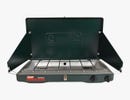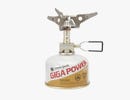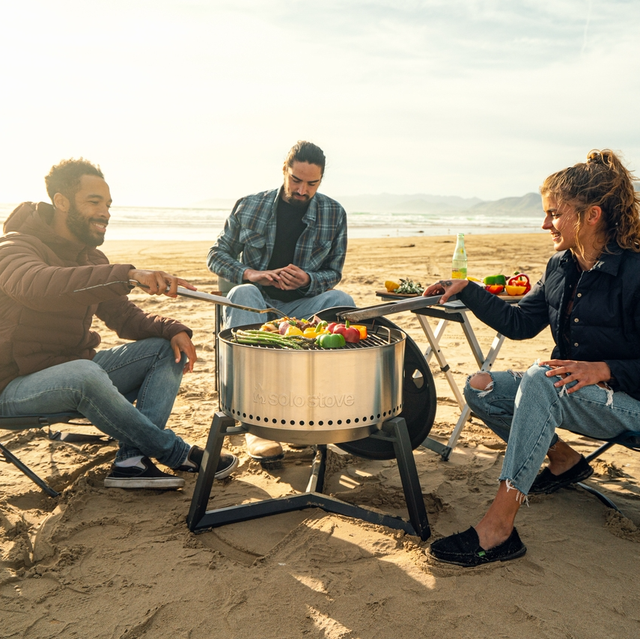




Wherever you're going, whatever you're cooking, there's a lightweight, portable, rugged stove for you.

For casual, amateur campers, campground cooking is probably mostly relegated to the likes of s'mores, hot dogs and anything else that can be stuck on a stick and held over an open flame. And it might not even go that far — many folks are content to premake sandwiches and bring them along and/or stick to simple snacks, like trail mix (AKA gorp). But we're here to tell you that there's a better way, should you wish for your camping meals to stray from the simplistic and reach more into the realm of the culinary.
If you're a fan of homecooked meals and you'd like to bring that passion to your outdoor adventures, you're going to need a camp stove. Available in a wide variety of sizes, shapes, weights, fuel types and numerous other metrics, these clever devices are designed to bring the convenience of your home kitchen to the campground, making it easier to gain access to an efficient, high-temperature flame and, therefore, greater cooking power than, say, a traditional campfire.
The next time you're ready to worm your way out of your sleeping bag, roll off your camp cot and eat a hearty breakfast out on the trails, you'll be thankful you've brought with you one of the best camping stoves you can buy in 2022 — which we've gathered in this guide. From ultralight backpacking offerings to fully-featured multi-burners, the perfect camping stove for you and yours is waiting for you right here.
Format: When it comes to this metric, there are really only two categories of camp stoves that anyone needs to worry about. They are standalone and tabletop. As you might have guessed from their names, standalone camp stoves are freestanding (typically, they have their own legs and/or base) and require no additional base in order to function, whereas tabletop stoves require a surface on which to place them. Standalones are typically better for single-person, low-capacity camping (like backpacking trips) and tend to favor lightness and packability, and tabletop stoves are typically larger, more feature-rich and serve larger groups better.
Size, Weight and Packability: While the format of stove you choose will likely impact this greatly, it's still something you want to think about when shopping as, even within the smaller format categories, there are a lot of variations. For backpacking and low-capacity camping, something much smaller and more packable will serve you best. Larger camp stoves tend to have more features but that also means greater weight and not as much packability, lending better to things like car, trailer or RV camping. Just be careful to pay attention to these metrics before you buy, as you can't really make a stove smaller, lighter, or more packable once you've bought it.
Fuel Type and Capacity: Most camp stoves run on gas, usually butane or propane, which have important pros and cons to be mindful of. Camping stoves also aren't designed to be interchangeable with either fuel type out of the box, so it's essential to fully understand the distinctions of each fuel source to identify the right camping stove for your particular needs.
Propane is generally easier to purchase from gas stations, grocery stores and hardware stores. It's also sold in refillable bottles, making it less wasteful. Keep in mind though that popular propane stoves made by Coleman and others may require an adapter hose to connect to the larger, non-proprietary propane tanks you're used to seeing next to grills and outdoor heaters. Lastly, propane burns effectively within a wide range of altitudes and temperatures.
The big downside of propane is that it has to be stored under higher pressure, which requires propane containers to be made from tough, heavy materials like stainless steel. In car camping scenarios, the added bulk and weight of a propane container is often a minor inconvenience to deal with relative to propane's upsides. While the 20-gallon propane tanks commonly sold for home grills contain plenty of gas for extended camping trips, we recommend purchasing a smaller five-gallon tank such as Ignik's Refillable Propane Growler with an included adapter hose and carrying case for weekend trips.
Butane canisters are less widely available, though still easily found in most outdoor gear stores. Butane's primary advantage over propane is that it's stored under lower pressure, allowing the gas to be safely contained in lighter aluminum canisters. This storage advantage makes Butane gas a far lighter fuel source to pack and haul. Frustratingly, though, Butane containers are not refillable, making them a more significant source of waste. Butane fuel can also struggle to perform effectively in extremely cold conditions.
Beyond these two common gases, some stoves also use solid fuel pucks, wood, and other natural kindling (make sure you're careful about rules and regulations wherever you might camp), and even alcohol. We'd highly recommend picking a stove that prioritizes gas due to simplicity and availability, but some can burn multiple types, which are great in a pinch. Fuel capacity only refers to gas-based stoves. The size of the canister determines the fuel capacity you get.
Number of Burners: Moreso than anything, the number of burners a camp stove has is a matter of convenience. Single-burner stoves are the easiest to transport, but they require the most time cooking since you only have access to a single heat source. Multi-burner stoves are harder to haul around (a two-burner stove is usually twice the size of a single) but they make for a much more convenient cooking experience, as you can heat up multiple skillets, pans, etc.
BTUs: Short for British Thermal Unit, a BTU is a measurement of the amount of energy needed to heat a pound of water by a degree Fahrenheit — and this is the standard for measuring the heat output of a camping stove in the USA. The higher the BTUs of a stove, the higher the heat it outputs. For the average camper, this is more a measure of convenience than anything else, as most halfway decent stoves will do the job in time. But if you're impatient, a high-BTU stove is probably going to be what you want.
Ignition Type: Most camp stoves operate with manual ignition — meaning you have to supply a spark via a match, flint and tinder, or something similar (like MSR's Handheld Piezo Igniter). However, some come with a push-button ignition (usually a built-in Piezo igniter). We don't think it's a necessity (lighting with a match or lighter is really simple, even with a breeze) but it is pretty convenient.
Extra Features: Depending on how and what you want to cook, there are countless other features to consider. For instance, if you want to bring a skillet along, you'll want to make sure you have a camp stove that can bear the weight of a skillet over its flame — some come with built-in support arms and others have ones that are optional/detachable. Once you've considered the rest of the above metrics, that's when you'll want to take a gander at the smaller details and see if they fit your requirements. However, we believe the six preceding metrics are the direst when selecting your ideal camp stove.